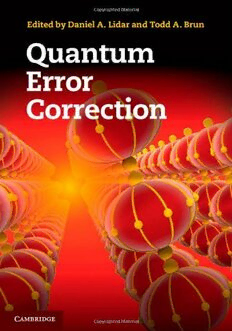Table Of ContentQUANTUM ERROR CORRECTION
Quantumcomputationandinformationareamongthemostexcitingdevelopmentsinscienceand
technologyofthelast20years.Toachievelarge-scalequantumcomputersandcommunication
networks it is essential to overcome noise not only in stored quantum information, but also in
generalfaultyquantumoperations.Scalablequantumcomputersrequireafar-reachingtheoryof
fault-tolerantquantumcomputation.
This comprehensive text, written by leading experts in the field, focuses on quantum error
correction,andthoroughlycoversthetheoryaswellasexperimentalandpracticalissues.Thebook
isnotlimitedtoasingleapproach,butalsoreviewsmanydifferentmethodstocontrolquantum
errors,includingtopologicalcodes,dynamicaldecoupling,anddecoherence-freesubspaces.
Basicsubjectsaswellasadvancedtheoryandasurveyoftopicsfromcutting-edgeresearch
make this book invaluable both as a pedagogical introduction at the graduate level and as a
referenceforexpertsinquantuminformationscience.
daniel a. lidar is a Professor of Electrical Engineering, Chemistry, and Physics at the
UniversityofSouthernCalifornia,anddirectstheUSCCenterforQuantumInformationScience
andTechnology.HereceivedhisPh.D.inPhysicsfromtheHebrewUniversityofJerusalem,was
a postdoctoral fellow at UC Berkeley, and a faculty member at the University of Toronto. He
was elected a Fellow of the American Association for the Advancement of Science and of the
American Physical Society for his contributions to the theory of decoherence control of open
quantumsystemsforquantuminformationprocessing.
todd a. brun is an Associate Professor of Electrical Engineering, Physics, and Computer
Science at the University of Southern California. He received his Ph.D. from the California
InstituteofTechnology,andheldpostdoctoralpositionsattheUniversityofLondon,theInstitute
for Theoretical Physics in Santa Barbara, Carnegie Mellon University, and the Institute for
AdvancedStudyinPrinceton.Hehasworkedbroadlyondecoherenceandthequantumtheoryof
opensystems,quantumerrorcorrection,andrelatedtopicsforquantuminformationprocessing.
QUANTUM ERROR CORRECTION
Editedby
DANIEL A. LIDAR
UniversityofSouthernCalifornia
TODD A. BRUN
UniversityofSouthernCalifornia
UniversityPrintingHouse,CambridgeCB28BS,UnitedKingdom
PublishedintheUnitedStatesofAmericabyCambridgeUniversityPress,NewYork
CambridgeUniversityPressispartoftheUniversityofCambridge.
ItfurtherstheUniversity’smissionbydisseminatingknowledgeinthepursuitof
education,learningandresearchatthehighestinternationallevelsofexcellence.
www.cambridge.org
Informationonthistitle:www.cambridge.org/9780521897877
(cid:2)C CambridgeUniversityPress2013
Thispublicationisincopyright.Subjecttostatutoryexception
andtotheprovisionsofrelevantcollectivelicensingagreements,
noreproductionofanypartmaytakeplacewithoutthewritten
permissionofCambridgeUniversityPress.
Firstpublished2013
PrintedintheUnitedKingdombyCPIGroupLtd,CroydonCR04YY
AcatalogrecordforthispublicationisavailablefromtheBritishLibrary
ISBN978-0-521-89787-7Hardback
CambridgeUniversityPresshasnoresponsibilityforthepersistenceoraccuracyof
URLsforexternalorthird-partyinternetwebsitesreferredtointhispublication,
anddoesnotguaranteethatanycontentonsuchwebsitesis,orwillremain,
accurateorappropriate.
Contents
Listofcontributors pagexi
Prologue xv
Prefaceandguidetothereader xix
Acknowledgements xxi
PartI Background 1
1 Introductiontodecoherenceandnoiseinopenquantumsystems 3
DanielA.LidarandToddA.Brun
1.1 Introduction 3
1.2 Briefintroductiontoquantummechanicsandquantumcomputing 4
1.3 Masterequations 26
1.4 Stochasticerrormodels 32
1.5 Conclusions 45
2 Introductiontoquantumerrorcorrection 46
DaveBacon
2.1 Errorcorrection 46
2.2 Fromreversibleclassicalerrorcorrectiontosimplequantumerrorcorrection 48
2.3 Thequantumerror-correctingcriterion 56
2.4 Thedistanceofaquantumerror-correctingcode 59
2.5 Content of the quantum error-correcting criterion and the quantum
Hammingbound 59
2.6 Digitizingquantumnoise 60
2.7 Classicallinearcodes 61
2.8 Calderbank,Shor,andSteanecodes 64
2.9 Stabilizerquantumerror-correctingcodes 65
2.10 Conclusions 76
2.11 Historyandfurtherreading 76
v
vi Contents
3 Introductiontodecoherence-freesubspacesandnoiselesssubsystems 78
DanielA.Lidar
3.1 Introduction 78
3.2 A“classicaldecoherence-freesubspace” 78
3.3 Collectivedephasingdecoherence-freesubspace 79
3.4 Decoherence-freesubspacedefinedandcharacterized 81
3.5 Initialization-freedecoherence-freesubspace 90
3.6 Noiselesssubsystems 92
3.7 Initialization-freenoiselesssubsystems 98
3.8 Protectionagainstadditionaldecoherencesources 101
3.9 Conclusions 102
3.10 Historyandfurtherreading 102
4 Introductiontoquantumdynamicaldecoupling 105
LorenzaViola
4.1 Motivationandoverview 105
4.2 Warmup:bang-bangdecouplingofqubitdephasing 107
4.3 Control-theoreticframework 110
4.4 Bang-bangperiodicdecoupling 113
4.5 Theneedforadvanceddecouplingdesign 119
4.6 Bounded-strengthEuleriandecoupling 120
5 Introductiontoquantumfaulttolerance 126
PanosAliferis
5.1 Quantumcircuitsanderrordiscretization 127
5.2 Noisyquantumcomputers 130
5.3 Encodedquantumcomputation 142
5.4 Coarse-grainednoiseandlevelreduction 152
5.5 Thequantumaccuracythreshold 155
5.6 Assessment 157
5.7 Historyandfurtherreading 158
PartII Generalizedapproachestoquantumerrorcorrection 161
6 Operatorquantumerrorcorrection 163
DavidKribsandDavidPoulin
6.1 Introduction 163
6.2 EquivalentconditionsforOQEC 165
6.3 StabilizerformalismforOQEC 169
6.4 Examples 172
6.5 Measuringgaugeoperators 175
6.6 Boundsforsubsystemcodes 177
6.7 Unitarilycorrectablecodes 179
7 Entanglement-assistedquantumerror-correctingcodes 181
ToddA.BrunandMin-HsiuHsieh
7.1 Introduction 181
7.2 ConstructingEAQECCs 184
Contents vii
7.3 ConstructingEAQECCsfromclassicallinearcodes 195
7.4 CatalyticQECCs 197
7.5 Conclusions 199
8 Continuous-timequantumerrorcorrection 201
OgnyanOreshkov
8.1 Introduction 201
8.2 CTQECinanencodedbasis 204
8.3 Quantum-jumpCTQECwithweakmeasurements 207
8.4 Schemeswithindirectfeedback 213
8.5 QuantumjumpsforMarkovianandnon-Markoviannoise 218
8.6 Outlook 226
PartIII Advancedquantumcodes 229
9 Quantumconvolutionalcodes 231
MarkWilde
9.1 Introduction 231
9.2 Definitionandoperationofquantumconvolutionalcodes 235
9.3 Mathematicalformalismofquantumconvolutionalcodes 238
9.4 Quantumshift-registercircuits 244
9.5 Examplesofquantumconvolutionalcodes 249
9.6 Entanglement-assistedquantumconvolutionalcodes 253
9.7 Closingremarks 260
10 Nonadditivequantumcodes 261
MarkusGrasslandMartinRo¨tteler
10.1 Introduction 261
10.2 Stabilizercodes 262
10.3 Characterizationofnonadditivequantumcodes 263
10.4 ConstructionofnonadditiveQECCs 268
10.5 Quantumcircuits 274
10.6 Conclusions 277
11 Iterativequantumcodingsystems 279
DavidPoulin
11.1 Introduction 279
11.2 Decoding 284
11.3 Turbo-codes 292
11.4 Sparsecodes 297
11.5 Conclusion 305
12 Algebraicquantumcodingtheory 307
AndreasKlappenecker
12.1 Quantumstabilizercodes 307
12.2 Cycliccodes 317
12.3 QuantumBCHcodes 318
12.4 QuantumMDScodes 325
viii Contents
13 Optimization-basedquantumerrorcorrection 327
AndrewFletcher
13.1 Limitationoftheindependentarbitraryerrorsmodel 327
13.2 DefiningaQECoptimizationproblem 328
13.3 Maximizingaverageentanglementfidelity 331
13.4 Minimizingchannelnonideality:theindirectmethod 336
13.5 Robustnesstochannelperturbations 338
13.6 Structurednear-optimaloptimization 340
13.7 Optimizationfor(approximate)decoherence-freesubspaces 346
13.8 Conclusion 347
PartIV Advanceddynamicaldecoupling 349
14 High-orderdynamicaldecoupling 351
Zhen-YuWangandRen-BaoLiu
14.1 Introduction 351
14.2 Operatorsetpreservation 351
14.3 Dynamicaldecouplingformulti-qubitsystems 353
14.4 Concatenateddynamicaldecoupling 355
14.5 Uhrigdynamicaldecoupling 357
14.6 ConcatenatedUhrigdynamicaldecoupling 365
14.7 Quadraticdynamicaldecoupling 366
14.8 NestedUhrigdynamicaldecoupling 367
14.9 Pulsesoffiniteamplitude 368
14.10 Time-dependentHamiltonians 369
14.11 Randomizeddynamicaldecoupling 372
14.12 Experimentalprogress 373
14.13 Discussion 374
15 Combinatorialapproachestodynamicaldecoupling 376
MartinRo¨ttelerandPawelWocjan
15.1 Introduction 376
15.2 Combinatorialbang-bangdecoupling 378
15.3 Combinatorialboundedstrengthdecoupling 391
15.4 Conclusionsandfuturedirections 393
PartV Alternativequantumcomputationapproaches 395
16 Holonomicquantumcomputation 397
PaoloZanardi
16.1 Introduction 397
16.2 Holonomicquantumcomputation 398
16.3 HQCwithquantumdots 400
16.4 Robustness 403
16.5 HybridizingHQCanderror-avoiding/correctingtechniques 406
16.6 Conclusions 407
Appendix:quantumholonomies 408

